Impact of Nursing Knowledge on HAIs: Hand Hygiene Protocol & PPE
VerifiedAdded on 2023/05/28
|16
|3697
|219
Project
AI Summary
This nursing project investigates the impact of nursing knowledge of hand hygiene protocols and the use of personal protective equipment (PPE) on reducing hospital-acquired infections (HAIs) in Australia, where HAIs contribute to increased healthcare costs and longer hospital stays. Focusing on nurses as a key group due to their constant patient interaction, the study employs a qualitative research approach, involving open-ended interviews with three nurse managers. Phenomenological analysis of the interview transcripts reveals two main themes: the importance of training in increasing compliance with hygiene protocols and the necessity of readily available resources to support compliance. The findings suggest that comprehensive training enhances nurses' awareness and adherence to hand hygiene practices, while adequate resources, such as accessible hand sanitizers and PPE, are crucial for effective infection control. This project highlights the critical role of nursing knowledge and resources in preventing HAIs.
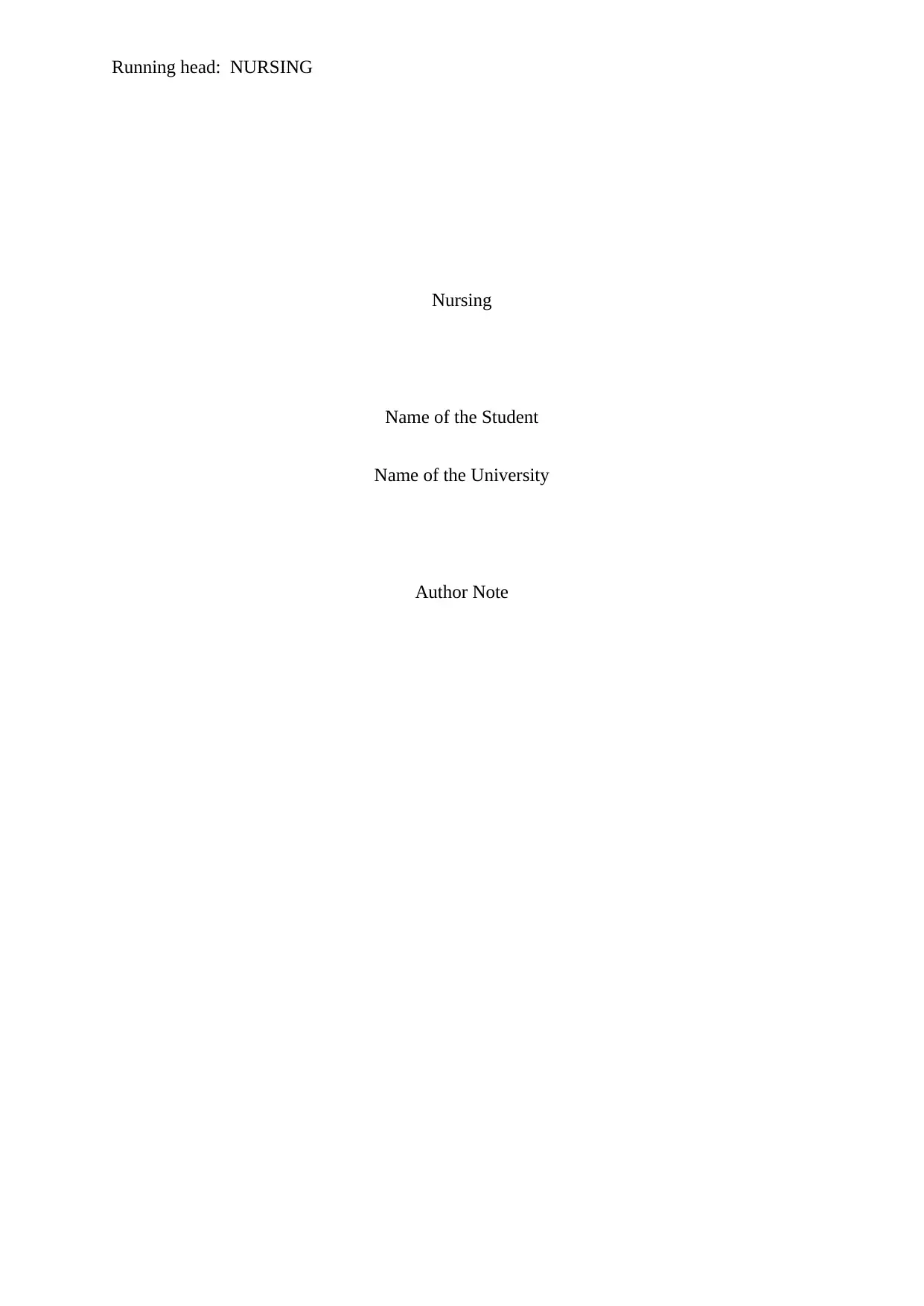
Running head: NURSING
Nursing
Name of the Student
Name of the University
Author Note
Nursing
Name of the Student
Name of the University
Author Note
Paraphrase This Document
Need a fresh take? Get an instant paraphrase of this document with our AI Paraphraser
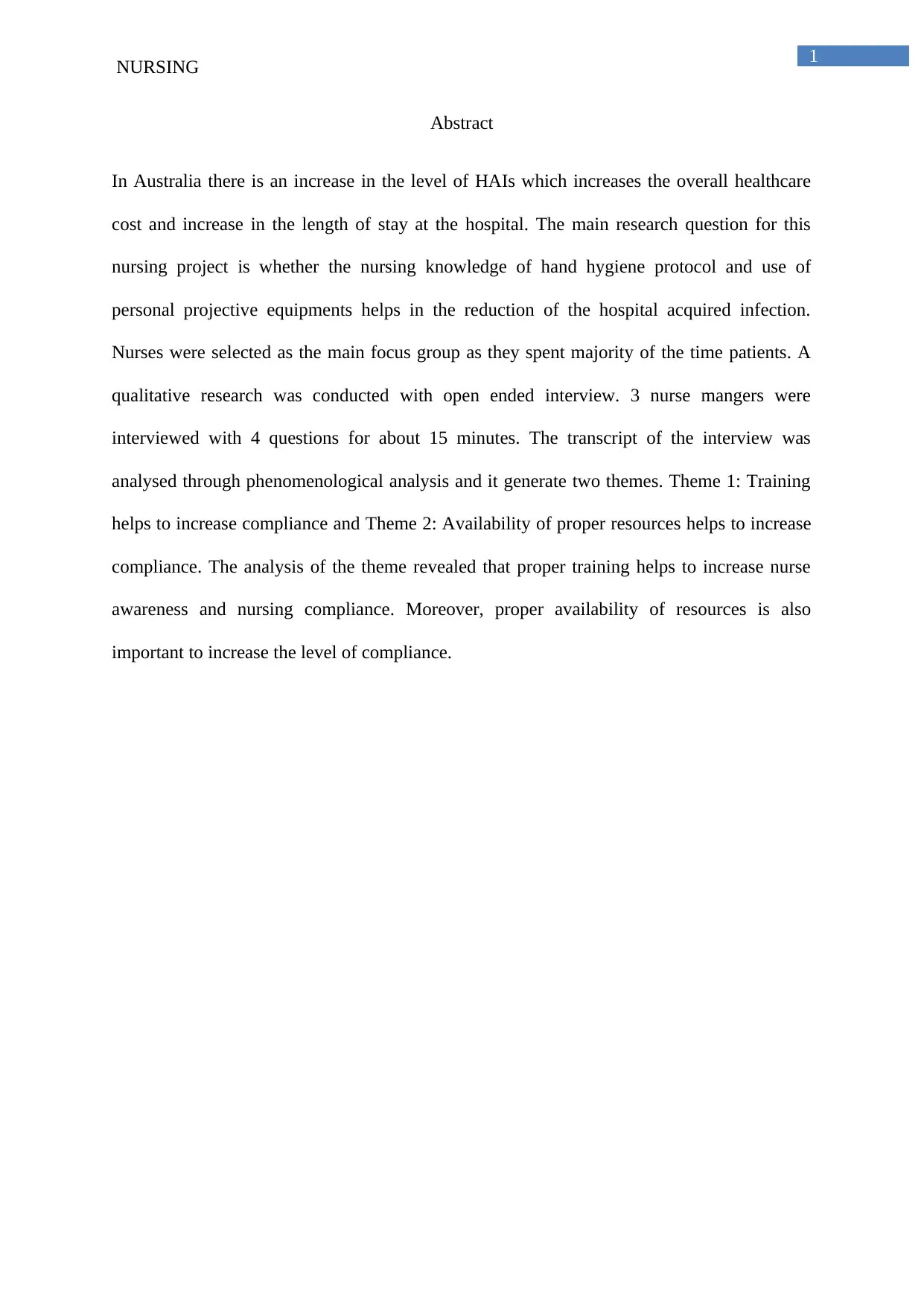
1
NURSING
Abstract
In Australia there is an increase in the level of HAIs which increases the overall healthcare
cost and increase in the length of stay at the hospital. The main research question for this
nursing project is whether the nursing knowledge of hand hygiene protocol and use of
personal projective equipments helps in the reduction of the hospital acquired infection.
Nurses were selected as the main focus group as they spent majority of the time patients. A
qualitative research was conducted with open ended interview. 3 nurse mangers were
interviewed with 4 questions for about 15 minutes. The transcript of the interview was
analysed through phenomenological analysis and it generate two themes. Theme 1: Training
helps to increase compliance and Theme 2: Availability of proper resources helps to increase
compliance. The analysis of the theme revealed that proper training helps to increase nurse
awareness and nursing compliance. Moreover, proper availability of resources is also
important to increase the level of compliance.
NURSING
Abstract
In Australia there is an increase in the level of HAIs which increases the overall healthcare
cost and increase in the length of stay at the hospital. The main research question for this
nursing project is whether the nursing knowledge of hand hygiene protocol and use of
personal projective equipments helps in the reduction of the hospital acquired infection.
Nurses were selected as the main focus group as they spent majority of the time patients. A
qualitative research was conducted with open ended interview. 3 nurse mangers were
interviewed with 4 questions for about 15 minutes. The transcript of the interview was
analysed through phenomenological analysis and it generate two themes. Theme 1: Training
helps to increase compliance and Theme 2: Availability of proper resources helps to increase
compliance. The analysis of the theme revealed that proper training helps to increase nurse
awareness and nursing compliance. Moreover, proper availability of resources is also
important to increase the level of compliance.
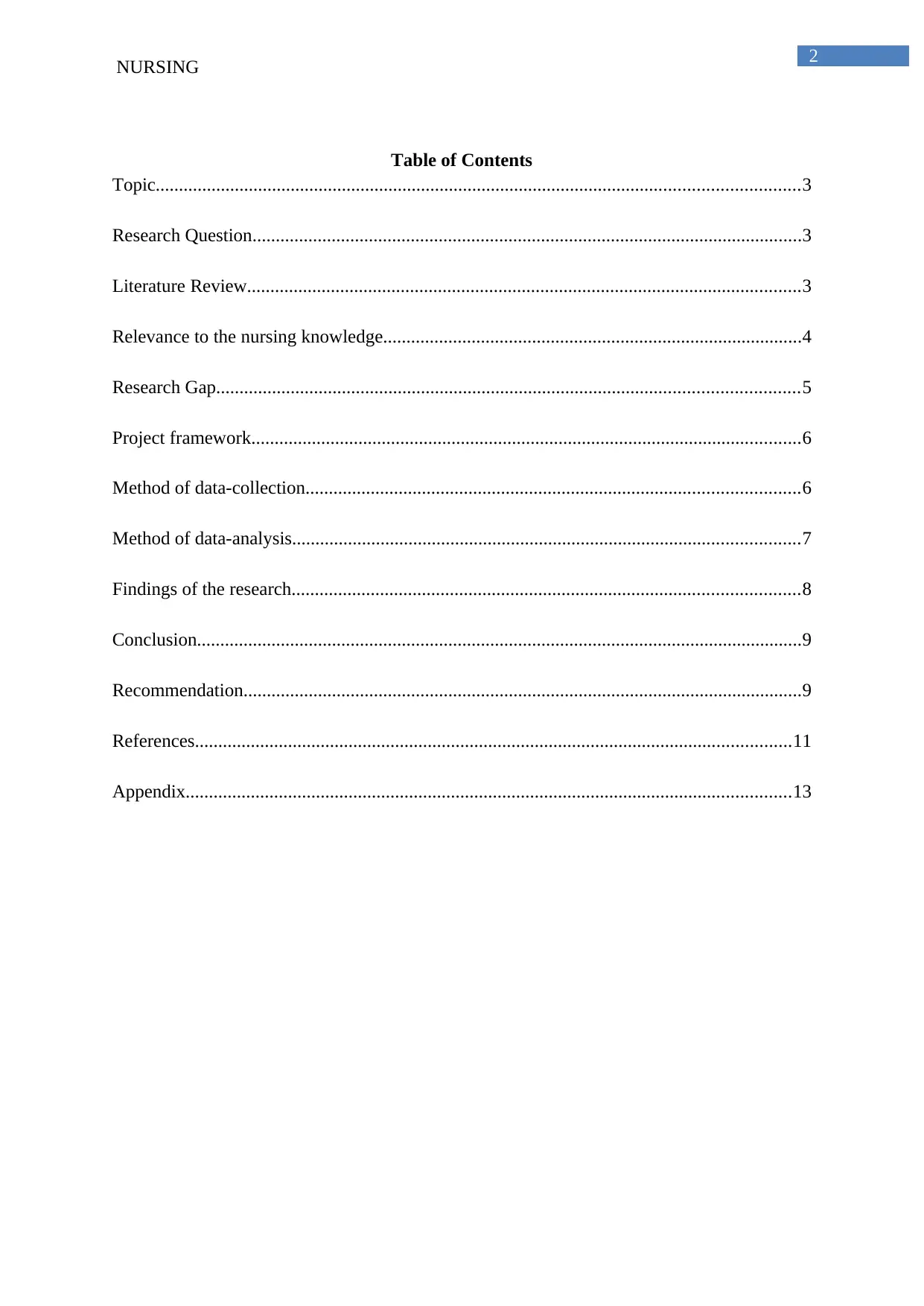
2
NURSING
Table of Contents
Topic..........................................................................................................................................3
Research Question......................................................................................................................3
Literature Review.......................................................................................................................3
Relevance to the nursing knowledge..........................................................................................4
Research Gap.............................................................................................................................5
Project framework......................................................................................................................6
Method of data-collection..........................................................................................................6
Method of data-analysis.............................................................................................................7
Findings of the research.............................................................................................................8
Conclusion..................................................................................................................................9
Recommendation........................................................................................................................9
References................................................................................................................................11
Appendix..................................................................................................................................13
NURSING
Table of Contents
Topic..........................................................................................................................................3
Research Question......................................................................................................................3
Literature Review.......................................................................................................................3
Relevance to the nursing knowledge..........................................................................................4
Research Gap.............................................................................................................................5
Project framework......................................................................................................................6
Method of data-collection..........................................................................................................6
Method of data-analysis.............................................................................................................7
Findings of the research.............................................................................................................8
Conclusion..................................................................................................................................9
Recommendation........................................................................................................................9
References................................................................................................................................11
Appendix..................................................................................................................................13
⊘ This is a preview!⊘
Do you want full access?
Subscribe today to unlock all pages.

Trusted by 1+ million students worldwide
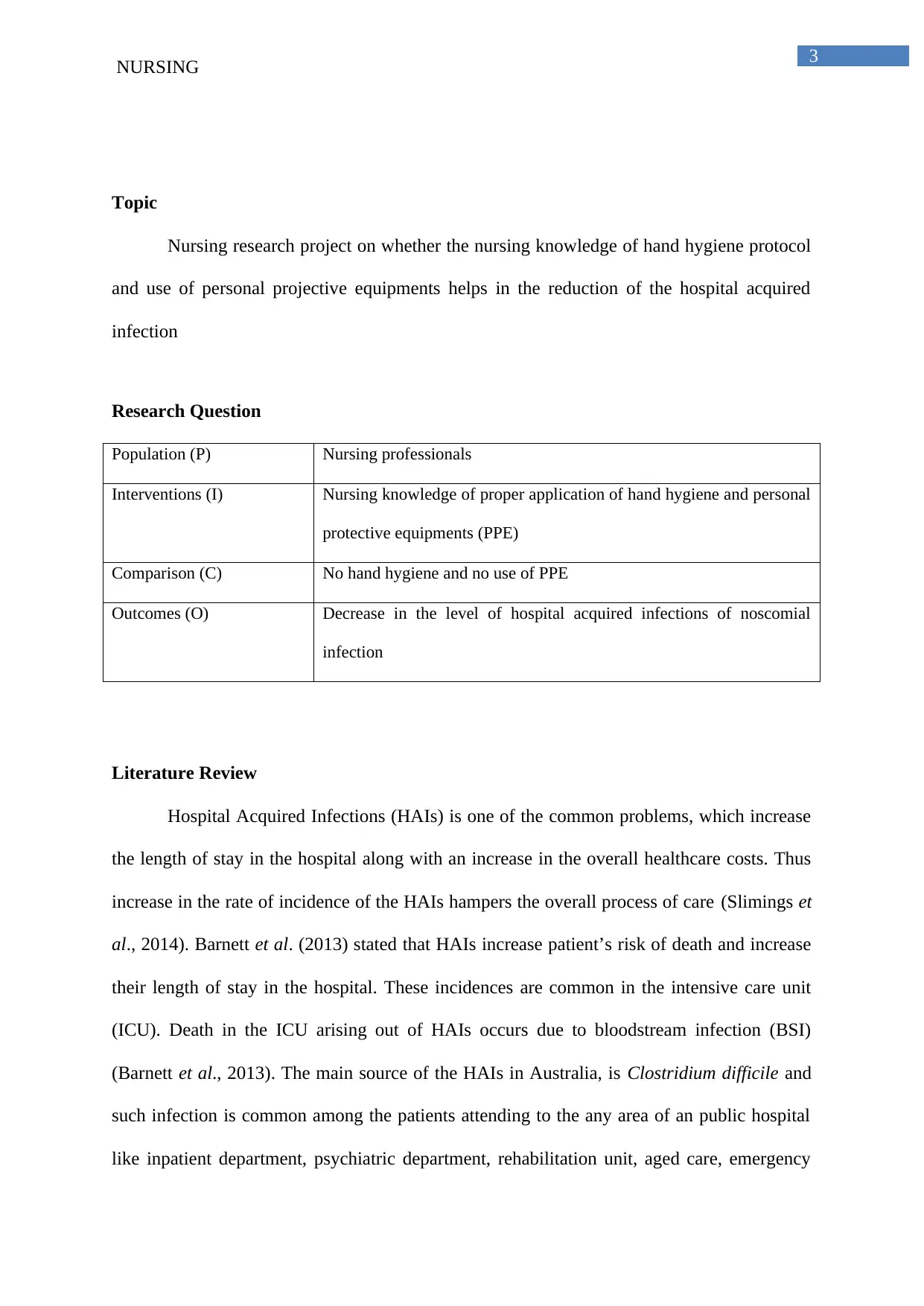
3
NURSING
Topic
Nursing research project on whether the nursing knowledge of hand hygiene protocol
and use of personal projective equipments helps in the reduction of the hospital acquired
infection
Research Question
Population (P) Nursing professionals
Interventions (I) Nursing knowledge of proper application of hand hygiene and personal
protective equipments (PPE)
Comparison (C) No hand hygiene and no use of PPE
Outcomes (O) Decrease in the level of hospital acquired infections of noscomial
infection
Literature Review
Hospital Acquired Infections (HAIs) is one of the common problems, which increase
the length of stay in the hospital along with an increase in the overall healthcare costs. Thus
increase in the rate of incidence of the HAIs hampers the overall process of care (Slimings et
al., 2014). Barnett et al. (2013) stated that HAIs increase patient’s risk of death and increase
their length of stay in the hospital. These incidences are common in the intensive care unit
(ICU). Death in the ICU arising out of HAIs occurs due to bloodstream infection (BSI)
(Barnett et al., 2013). The main source of the HAIs in Australia, is Clostridium difficile and
such infection is common among the patients attending to the any area of an public hospital
like inpatient department, psychiatric department, rehabilitation unit, aged care, emergency
NURSING
Topic
Nursing research project on whether the nursing knowledge of hand hygiene protocol
and use of personal projective equipments helps in the reduction of the hospital acquired
infection
Research Question
Population (P) Nursing professionals
Interventions (I) Nursing knowledge of proper application of hand hygiene and personal
protective equipments (PPE)
Comparison (C) No hand hygiene and no use of PPE
Outcomes (O) Decrease in the level of hospital acquired infections of noscomial
infection
Literature Review
Hospital Acquired Infections (HAIs) is one of the common problems, which increase
the length of stay in the hospital along with an increase in the overall healthcare costs. Thus
increase in the rate of incidence of the HAIs hampers the overall process of care (Slimings et
al., 2014). Barnett et al. (2013) stated that HAIs increase patient’s risk of death and increase
their length of stay in the hospital. These incidences are common in the intensive care unit
(ICU). Death in the ICU arising out of HAIs occurs due to bloodstream infection (BSI)
(Barnett et al., 2013). The main source of the HAIs in Australia, is Clostridium difficile and
such infection is common among the patients attending to the any area of an public hospital
like inpatient department, psychiatric department, rehabilitation unit, aged care, emergency
Paraphrase This Document
Need a fresh take? Get an instant paraphrase of this document with our AI Paraphraser
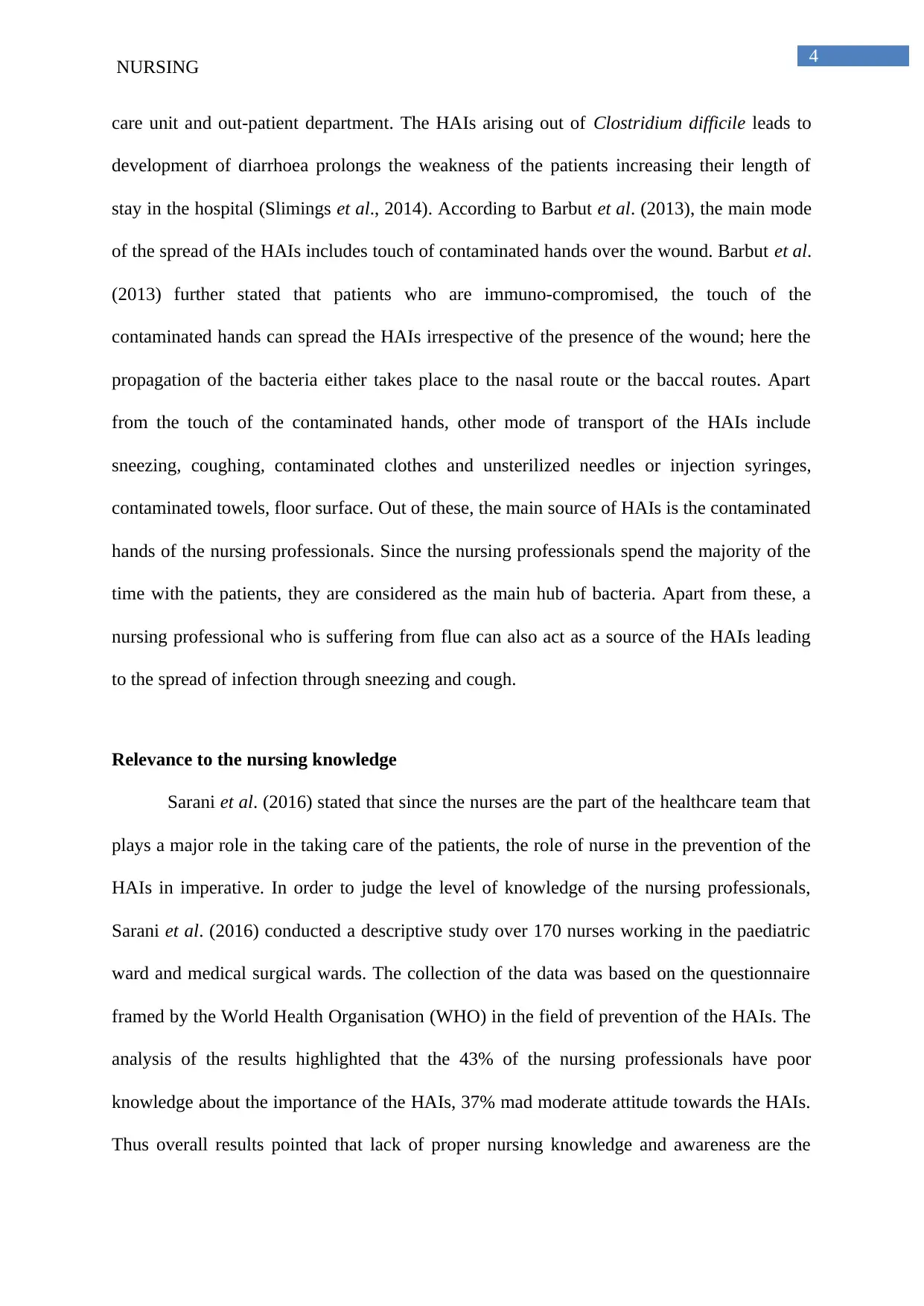
4
NURSING
care unit and out-patient department. The HAIs arising out of Clostridium difficile leads to
development of diarrhoea prolongs the weakness of the patients increasing their length of
stay in the hospital (Slimings et al., 2014). According to Barbut et al. (2013), the main mode
of the spread of the HAIs includes touch of contaminated hands over the wound. Barbut et al.
(2013) further stated that patients who are immuno-compromised, the touch of the
contaminated hands can spread the HAIs irrespective of the presence of the wound; here the
propagation of the bacteria either takes place to the nasal route or the baccal routes. Apart
from the touch of the contaminated hands, other mode of transport of the HAIs include
sneezing, coughing, contaminated clothes and unsterilized needles or injection syringes,
contaminated towels, floor surface. Out of these, the main source of HAIs is the contaminated
hands of the nursing professionals. Since the nursing professionals spend the majority of the
time with the patients, they are considered as the main hub of bacteria. Apart from these, a
nursing professional who is suffering from flue can also act as a source of the HAIs leading
to the spread of infection through sneezing and cough.
Relevance to the nursing knowledge
Sarani et al. (2016) stated that since the nurses are the part of the healthcare team that
plays a major role in the taking care of the patients, the role of nurse in the prevention of the
HAIs in imperative. In order to judge the level of knowledge of the nursing professionals,
Sarani et al. (2016) conducted a descriptive study over 170 nurses working in the paediatric
ward and medical surgical wards. The collection of the data was based on the questionnaire
framed by the World Health Organisation (WHO) in the field of prevention of the HAIs. The
analysis of the results highlighted that the 43% of the nursing professionals have poor
knowledge about the importance of the HAIs, 37% mad moderate attitude towards the HAIs.
Thus overall results pointed that lack of proper nursing knowledge and awareness are the
NURSING
care unit and out-patient department. The HAIs arising out of Clostridium difficile leads to
development of diarrhoea prolongs the weakness of the patients increasing their length of
stay in the hospital (Slimings et al., 2014). According to Barbut et al. (2013), the main mode
of the spread of the HAIs includes touch of contaminated hands over the wound. Barbut et al.
(2013) further stated that patients who are immuno-compromised, the touch of the
contaminated hands can spread the HAIs irrespective of the presence of the wound; here the
propagation of the bacteria either takes place to the nasal route or the baccal routes. Apart
from the touch of the contaminated hands, other mode of transport of the HAIs include
sneezing, coughing, contaminated clothes and unsterilized needles or injection syringes,
contaminated towels, floor surface. Out of these, the main source of HAIs is the contaminated
hands of the nursing professionals. Since the nursing professionals spend the majority of the
time with the patients, they are considered as the main hub of bacteria. Apart from these, a
nursing professional who is suffering from flue can also act as a source of the HAIs leading
to the spread of infection through sneezing and cough.
Relevance to the nursing knowledge
Sarani et al. (2016) stated that since the nurses are the part of the healthcare team that
plays a major role in the taking care of the patients, the role of nurse in the prevention of the
HAIs in imperative. In order to judge the level of knowledge of the nursing professionals,
Sarani et al. (2016) conducted a descriptive study over 170 nurses working in the paediatric
ward and medical surgical wards. The collection of the data was based on the questionnaire
framed by the World Health Organisation (WHO) in the field of prevention of the HAIs. The
analysis of the results highlighted that the 43% of the nursing professionals have poor
knowledge about the importance of the HAIs, 37% mad moderate attitude towards the HAIs.
Thus overall results pointed that lack of proper nursing knowledge and awareness are the
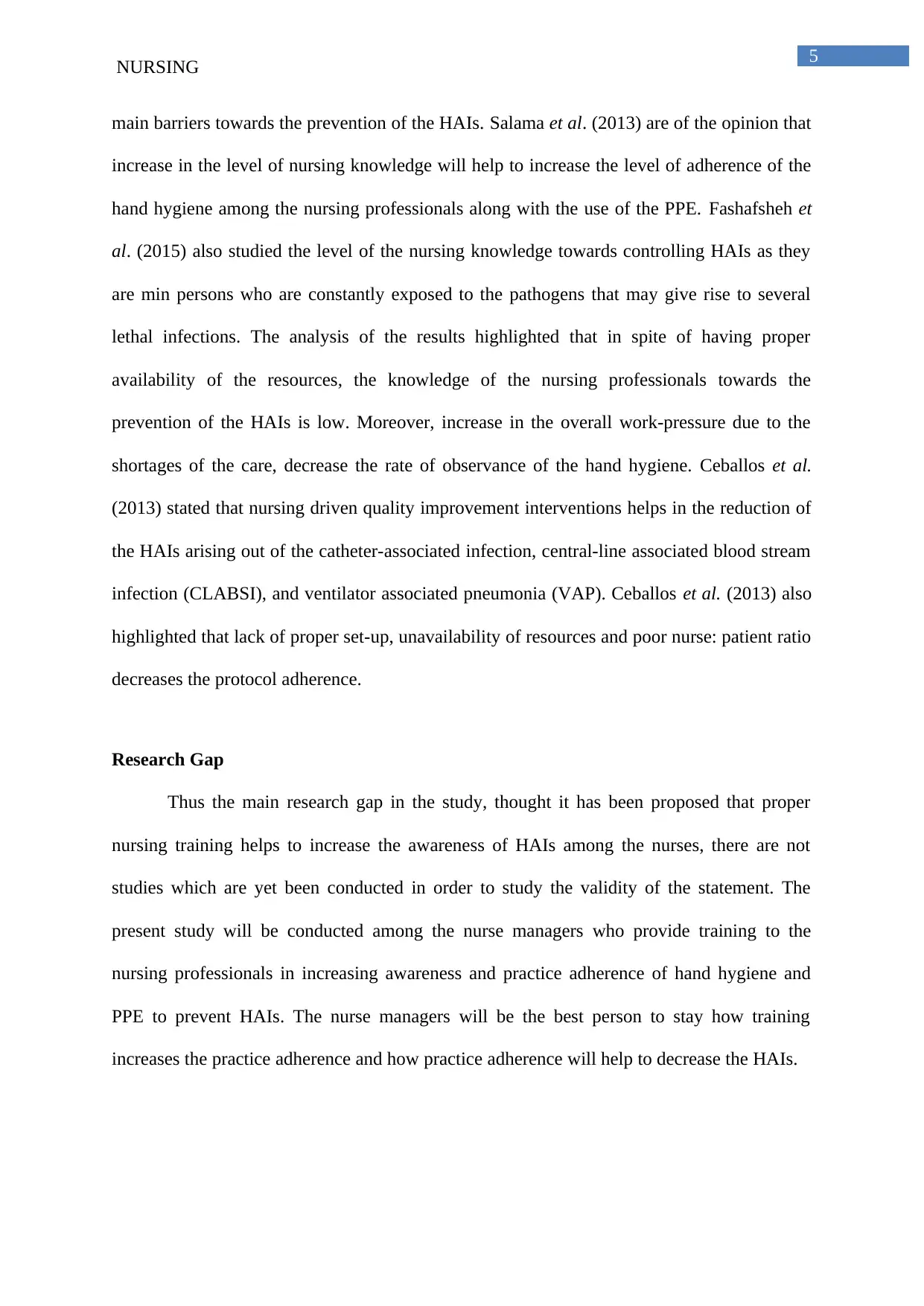
5
NURSING
main barriers towards the prevention of the HAIs. Salama et al. (2013) are of the opinion that
increase in the level of nursing knowledge will help to increase the level of adherence of the
hand hygiene among the nursing professionals along with the use of the PPE. Fashafsheh et
al. (2015) also studied the level of the nursing knowledge towards controlling HAIs as they
are min persons who are constantly exposed to the pathogens that may give rise to several
lethal infections. The analysis of the results highlighted that in spite of having proper
availability of the resources, the knowledge of the nursing professionals towards the
prevention of the HAIs is low. Moreover, increase in the overall work-pressure due to the
shortages of the care, decrease the rate of observance of the hand hygiene. Ceballos et al.
(2013) stated that nursing driven quality improvement interventions helps in the reduction of
the HAIs arising out of the catheter-associated infection, central-line associated blood stream
infection (CLABSI), and ventilator associated pneumonia (VAP). Ceballos et al. (2013) also
highlighted that lack of proper set-up, unavailability of resources and poor nurse: patient ratio
decreases the protocol adherence.
Research Gap
Thus the main research gap in the study, thought it has been proposed that proper
nursing training helps to increase the awareness of HAIs among the nurses, there are not
studies which are yet been conducted in order to study the validity of the statement. The
present study will be conducted among the nurse managers who provide training to the
nursing professionals in increasing awareness and practice adherence of hand hygiene and
PPE to prevent HAIs. The nurse managers will be the best person to stay how training
increases the practice adherence and how practice adherence will help to decrease the HAIs.
NURSING
main barriers towards the prevention of the HAIs. Salama et al. (2013) are of the opinion that
increase in the level of nursing knowledge will help to increase the level of adherence of the
hand hygiene among the nursing professionals along with the use of the PPE. Fashafsheh et
al. (2015) also studied the level of the nursing knowledge towards controlling HAIs as they
are min persons who are constantly exposed to the pathogens that may give rise to several
lethal infections. The analysis of the results highlighted that in spite of having proper
availability of the resources, the knowledge of the nursing professionals towards the
prevention of the HAIs is low. Moreover, increase in the overall work-pressure due to the
shortages of the care, decrease the rate of observance of the hand hygiene. Ceballos et al.
(2013) stated that nursing driven quality improvement interventions helps in the reduction of
the HAIs arising out of the catheter-associated infection, central-line associated blood stream
infection (CLABSI), and ventilator associated pneumonia (VAP). Ceballos et al. (2013) also
highlighted that lack of proper set-up, unavailability of resources and poor nurse: patient ratio
decreases the protocol adherence.
Research Gap
Thus the main research gap in the study, thought it has been proposed that proper
nursing training helps to increase the awareness of HAIs among the nurses, there are not
studies which are yet been conducted in order to study the validity of the statement. The
present study will be conducted among the nurse managers who provide training to the
nursing professionals in increasing awareness and practice adherence of hand hygiene and
PPE to prevent HAIs. The nurse managers will be the best person to stay how training
increases the practice adherence and how practice adherence will help to decrease the HAIs.
⊘ This is a preview!⊘
Do you want full access?
Subscribe today to unlock all pages.

Trusted by 1+ million students worldwide
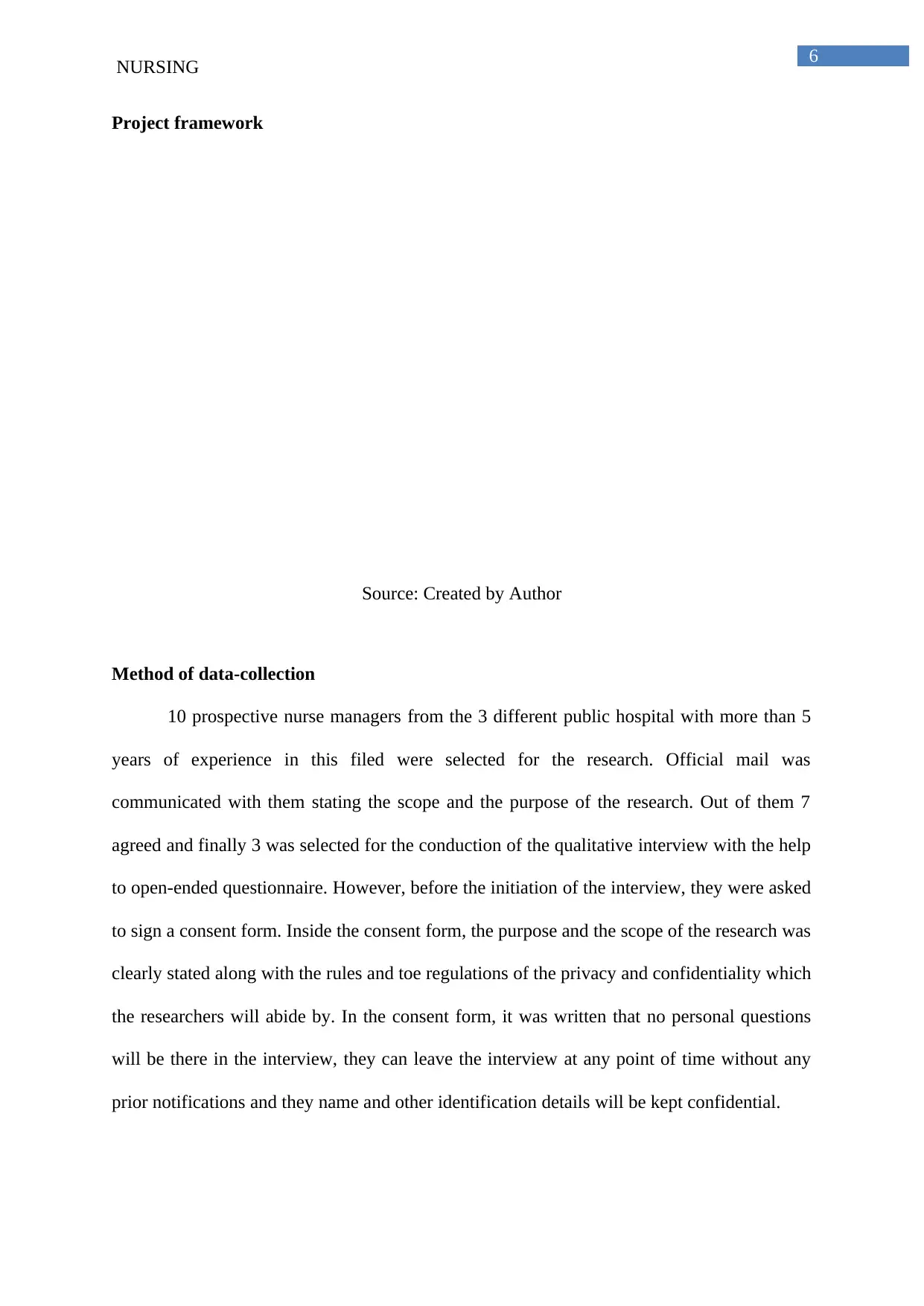
6
NURSING
Project framework
Source: Created by Author
Method of data-collection
10 prospective nurse managers from the 3 different public hospital with more than 5
years of experience in this filed were selected for the research. Official mail was
communicated with them stating the scope and the purpose of the research. Out of them 7
agreed and finally 3 was selected for the conduction of the qualitative interview with the help
to open-ended questionnaire. However, before the initiation of the interview, they were asked
to sign a consent form. Inside the consent form, the purpose and the scope of the research was
clearly stated along with the rules and toe regulations of the privacy and confidentiality which
the researchers will abide by. In the consent form, it was written that no personal questions
will be there in the interview, they can leave the interview at any point of time without any
prior notifications and they name and other identification details will be kept confidential.
Step:1IndeitifcationoftheresearchgapFramingoftheresearchquestionsStep:2IdentificationofthesampleandsamplesizeRecruitingtheselectedsampleintothestudywithproperethicalguidelinesStep:3Collectionofthequalitativedata(Qualitativedatacollectionthroughopen-endedquestionnairesfrom3nuremanagersoperaringinthreedifferentpublichospitals)Interpretationofthequalitativedata(transcriptformationfromtherecordedinterview)Step:4Analysisoftheresults(Qualitativedataanalysis
NURSING
Project framework
Source: Created by Author
Method of data-collection
10 prospective nurse managers from the 3 different public hospital with more than 5
years of experience in this filed were selected for the research. Official mail was
communicated with them stating the scope and the purpose of the research. Out of them 7
agreed and finally 3 was selected for the conduction of the qualitative interview with the help
to open-ended questionnaire. However, before the initiation of the interview, they were asked
to sign a consent form. Inside the consent form, the purpose and the scope of the research was
clearly stated along with the rules and toe regulations of the privacy and confidentiality which
the researchers will abide by. In the consent form, it was written that no personal questions
will be there in the interview, they can leave the interview at any point of time without any
prior notifications and they name and other identification details will be kept confidential.
Step:1IndeitifcationoftheresearchgapFramingoftheresearchquestionsStep:2IdentificationofthesampleandsamplesizeRecruitingtheselectedsampleintothestudywithproperethicalguidelinesStep:3Collectionofthequalitativedata(Qualitativedatacollectionthroughopen-endedquestionnairesfrom3nuremanagersoperaringinthreedifferentpublichospitals)Interpretationofthequalitativedata(transcriptformationfromtherecordedinterview)Step:4Analysisoftheresults(Qualitativedataanalysis
Paraphrase This Document
Need a fresh take? Get an instant paraphrase of this document with our AI Paraphraser
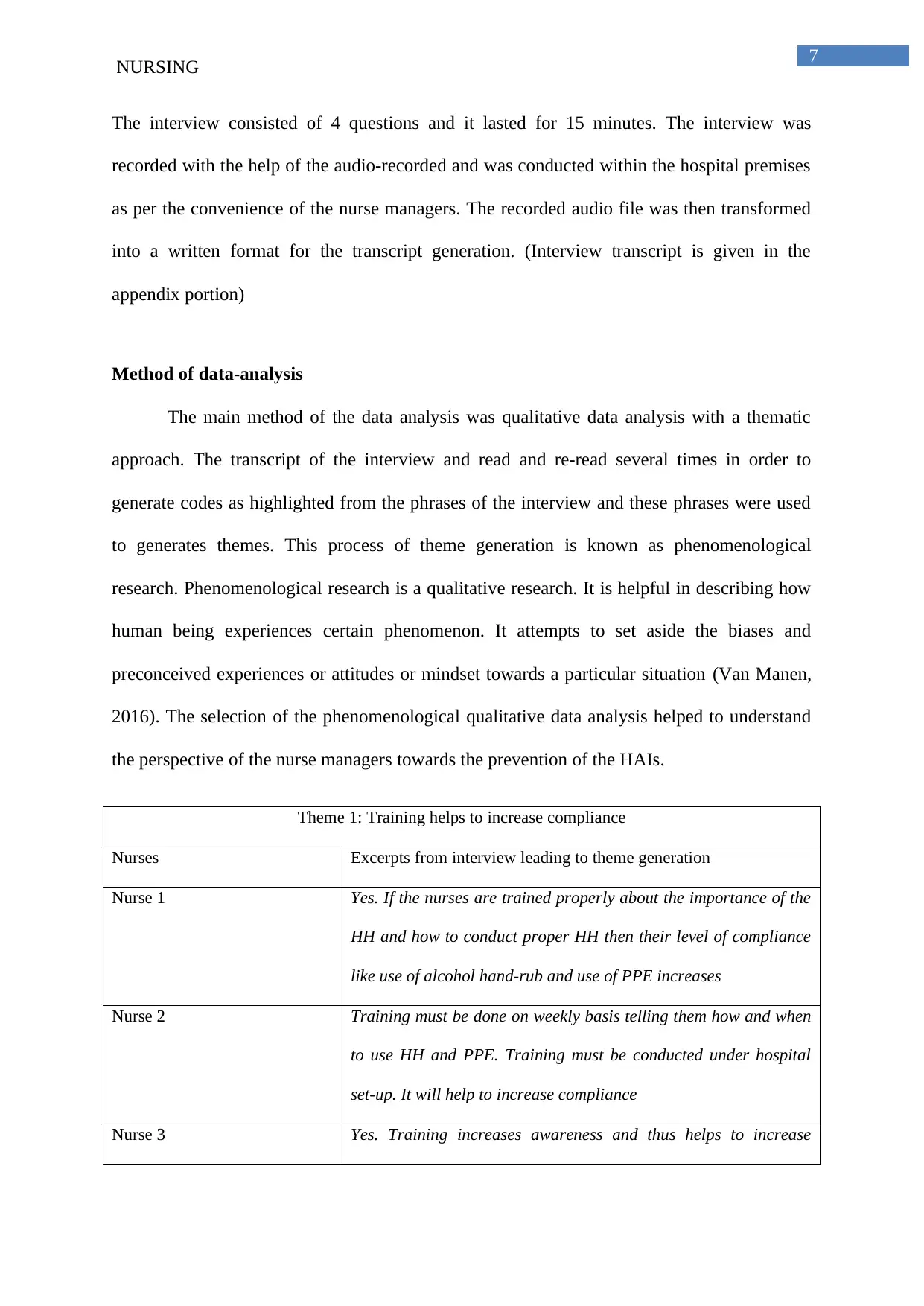
7
NURSING
The interview consisted of 4 questions and it lasted for 15 minutes. The interview was
recorded with the help of the audio-recorded and was conducted within the hospital premises
as per the convenience of the nurse managers. The recorded audio file was then transformed
into a written format for the transcript generation. (Interview transcript is given in the
appendix portion)
Method of data-analysis
The main method of the data analysis was qualitative data analysis with a thematic
approach. The transcript of the interview and read and re-read several times in order to
generate codes as highlighted from the phrases of the interview and these phrases were used
to generates themes. This process of theme generation is known as phenomenological
research. Phenomenological research is a qualitative research. It is helpful in describing how
human being experiences certain phenomenon. It attempts to set aside the biases and
preconceived experiences or attitudes or mindset towards a particular situation (Van Manen,
2016). The selection of the phenomenological qualitative data analysis helped to understand
the perspective of the nurse managers towards the prevention of the HAIs.
Theme 1: Training helps to increase compliance
Nurses Excerpts from interview leading to theme generation
Nurse 1 Yes. If the nurses are trained properly about the importance of the
HH and how to conduct proper HH then their level of compliance
like use of alcohol hand-rub and use of PPE increases
Nurse 2 Training must be done on weekly basis telling them how and when
to use HH and PPE. Training must be conducted under hospital
set-up. It will help to increase compliance
Nurse 3 Yes. Training increases awareness and thus helps to increase
NURSING
The interview consisted of 4 questions and it lasted for 15 minutes. The interview was
recorded with the help of the audio-recorded and was conducted within the hospital premises
as per the convenience of the nurse managers. The recorded audio file was then transformed
into a written format for the transcript generation. (Interview transcript is given in the
appendix portion)
Method of data-analysis
The main method of the data analysis was qualitative data analysis with a thematic
approach. The transcript of the interview and read and re-read several times in order to
generate codes as highlighted from the phrases of the interview and these phrases were used
to generates themes. This process of theme generation is known as phenomenological
research. Phenomenological research is a qualitative research. It is helpful in describing how
human being experiences certain phenomenon. It attempts to set aside the biases and
preconceived experiences or attitudes or mindset towards a particular situation (Van Manen,
2016). The selection of the phenomenological qualitative data analysis helped to understand
the perspective of the nurse managers towards the prevention of the HAIs.
Theme 1: Training helps to increase compliance
Nurses Excerpts from interview leading to theme generation
Nurse 1 Yes. If the nurses are trained properly about the importance of the
HH and how to conduct proper HH then their level of compliance
like use of alcohol hand-rub and use of PPE increases
Nurse 2 Training must be done on weekly basis telling them how and when
to use HH and PPE. Training must be conducted under hospital
set-up. It will help to increase compliance
Nurse 3 Yes. Training increases awareness and thus helps to increase
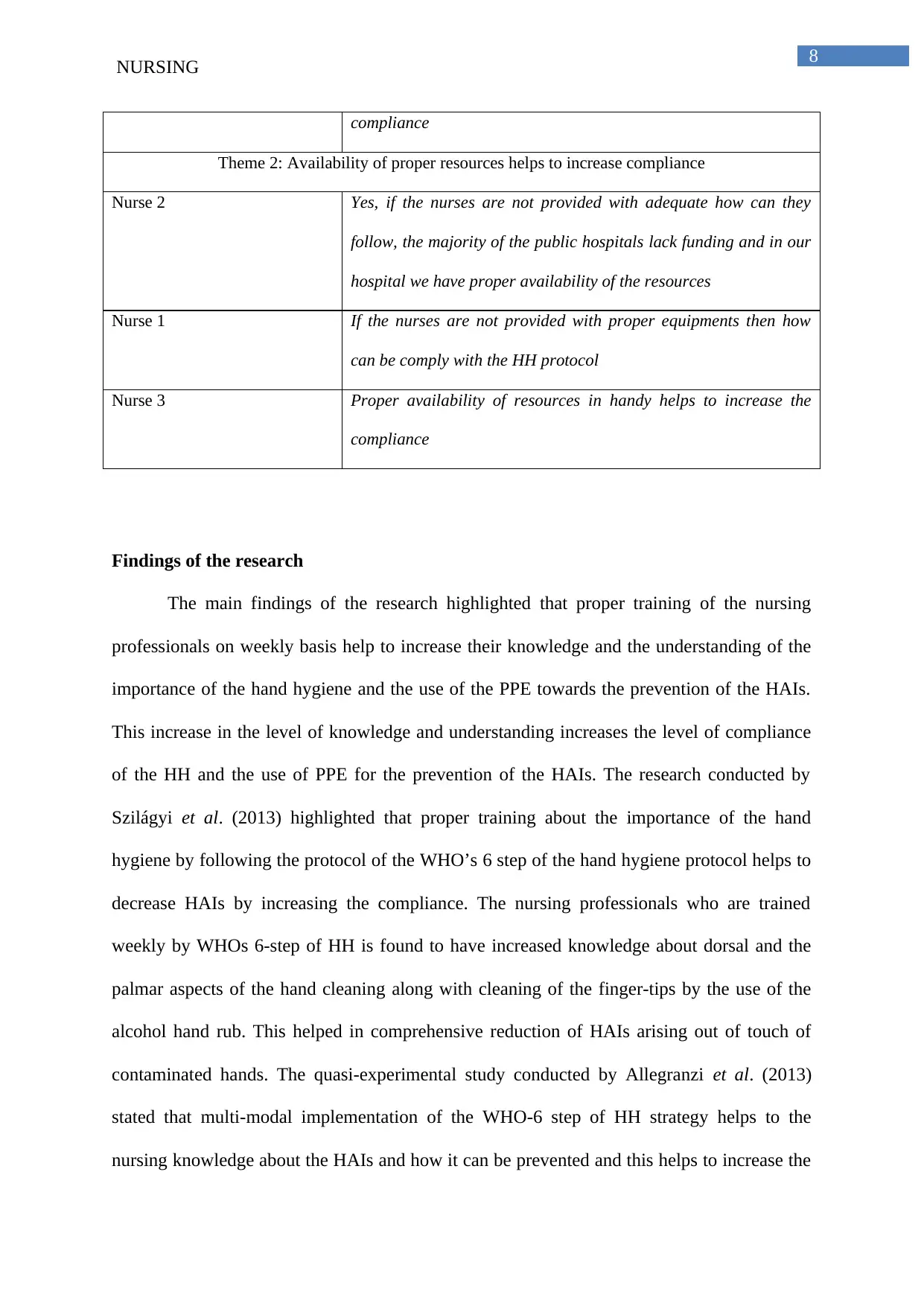
8
NURSING
compliance
Theme 2: Availability of proper resources helps to increase compliance
Nurse 2 Yes, if the nurses are not provided with adequate how can they
follow, the majority of the public hospitals lack funding and in our
hospital we have proper availability of the resources
Nurse 1 If the nurses are not provided with proper equipments then how
can be comply with the HH protocol
Nurse 3 Proper availability of resources in handy helps to increase the
compliance
Findings of the research
The main findings of the research highlighted that proper training of the nursing
professionals on weekly basis help to increase their knowledge and the understanding of the
importance of the hand hygiene and the use of the PPE towards the prevention of the HAIs.
This increase in the level of knowledge and understanding increases the level of compliance
of the HH and the use of PPE for the prevention of the HAIs. The research conducted by
Szilágyi et al. (2013) highlighted that proper training about the importance of the hand
hygiene by following the protocol of the WHO’s 6 step of the hand hygiene protocol helps to
decrease HAIs by increasing the compliance. The nursing professionals who are trained
weekly by WHOs 6-step of HH is found to have increased knowledge about dorsal and the
palmar aspects of the hand cleaning along with cleaning of the finger-tips by the use of the
alcohol hand rub. This helped in comprehensive reduction of HAIs arising out of touch of
contaminated hands. The quasi-experimental study conducted by Allegranzi et al. (2013)
stated that multi-modal implementation of the WHO-6 step of HH strategy helps to the
nursing knowledge about the HAIs and how it can be prevented and this helps to increase the
NURSING
compliance
Theme 2: Availability of proper resources helps to increase compliance
Nurse 2 Yes, if the nurses are not provided with adequate how can they
follow, the majority of the public hospitals lack funding and in our
hospital we have proper availability of the resources
Nurse 1 If the nurses are not provided with proper equipments then how
can be comply with the HH protocol
Nurse 3 Proper availability of resources in handy helps to increase the
compliance
Findings of the research
The main findings of the research highlighted that proper training of the nursing
professionals on weekly basis help to increase their knowledge and the understanding of the
importance of the hand hygiene and the use of the PPE towards the prevention of the HAIs.
This increase in the level of knowledge and understanding increases the level of compliance
of the HH and the use of PPE for the prevention of the HAIs. The research conducted by
Szilágyi et al. (2013) highlighted that proper training about the importance of the hand
hygiene by following the protocol of the WHO’s 6 step of the hand hygiene protocol helps to
decrease HAIs by increasing the compliance. The nursing professionals who are trained
weekly by WHOs 6-step of HH is found to have increased knowledge about dorsal and the
palmar aspects of the hand cleaning along with cleaning of the finger-tips by the use of the
alcohol hand rub. This helped in comprehensive reduction of HAIs arising out of touch of
contaminated hands. The quasi-experimental study conducted by Allegranzi et al. (2013)
stated that multi-modal implementation of the WHO-6 step of HH strategy helps to the
nursing knowledge about the HAIs and how it can be prevented and this helps to increase the
⊘ This is a preview!⊘
Do you want full access?
Subscribe today to unlock all pages.

Trusted by 1+ million students worldwide
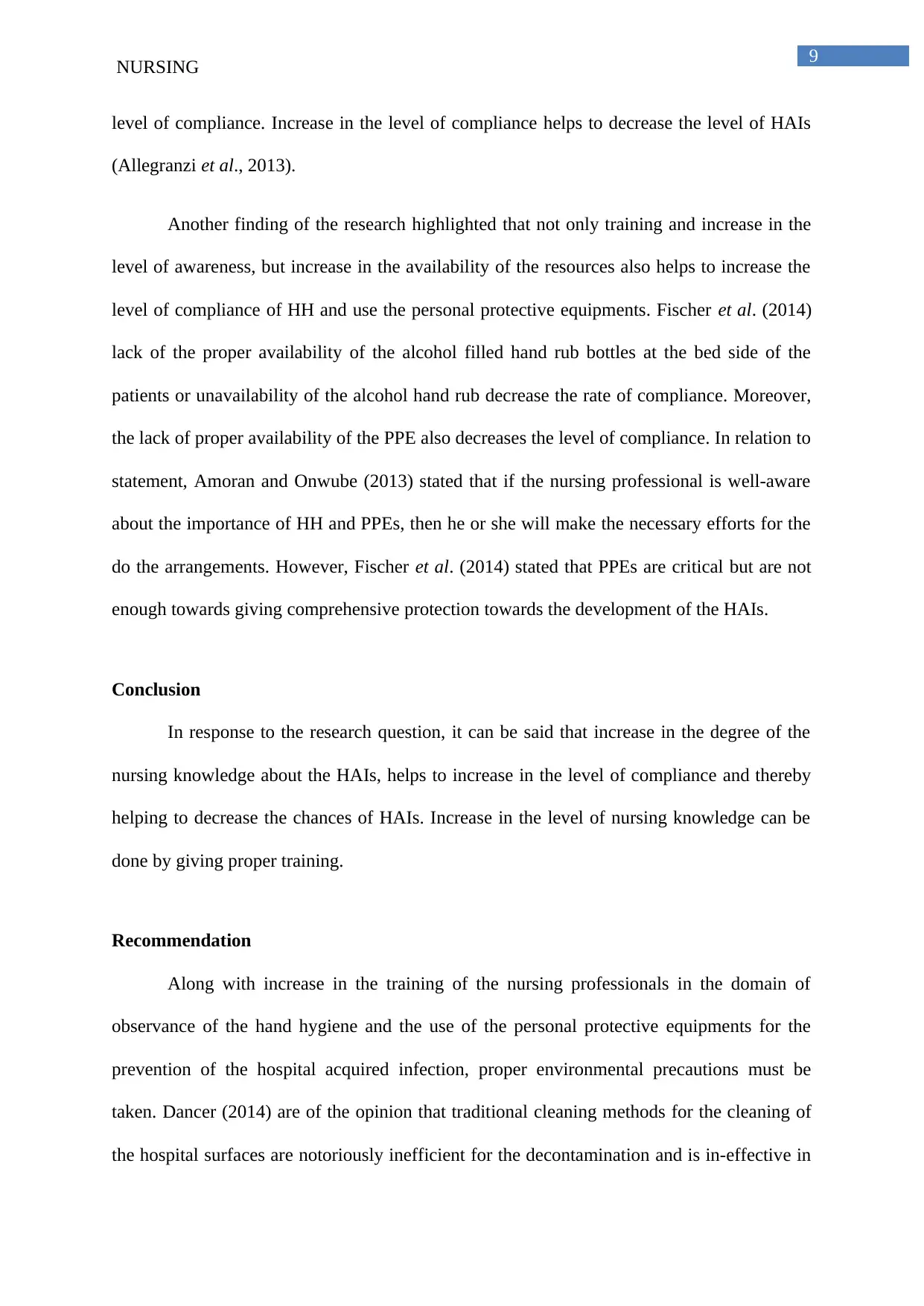
9
NURSING
level of compliance. Increase in the level of compliance helps to decrease the level of HAIs
(Allegranzi et al., 2013).
Another finding of the research highlighted that not only training and increase in the
level of awareness, but increase in the availability of the resources also helps to increase the
level of compliance of HH and use the personal protective equipments. Fischer et al. (2014)
lack of the proper availability of the alcohol filled hand rub bottles at the bed side of the
patients or unavailability of the alcohol hand rub decrease the rate of compliance. Moreover,
the lack of proper availability of the PPE also decreases the level of compliance. In relation to
statement, Amoran and Onwube (2013) stated that if the nursing professional is well-aware
about the importance of HH and PPEs, then he or she will make the necessary efforts for the
do the arrangements. However, Fischer et al. (2014) stated that PPEs are critical but are not
enough towards giving comprehensive protection towards the development of the HAIs.
Conclusion
In response to the research question, it can be said that increase in the degree of the
nursing knowledge about the HAIs, helps to increase in the level of compliance and thereby
helping to decrease the chances of HAIs. Increase in the level of nursing knowledge can be
done by giving proper training.
Recommendation
Along with increase in the training of the nursing professionals in the domain of
observance of the hand hygiene and the use of the personal protective equipments for the
prevention of the hospital acquired infection, proper environmental precautions must be
taken. Dancer (2014) are of the opinion that traditional cleaning methods for the cleaning of
the hospital surfaces are notoriously inefficient for the decontamination and is in-effective in
NURSING
level of compliance. Increase in the level of compliance helps to decrease the level of HAIs
(Allegranzi et al., 2013).
Another finding of the research highlighted that not only training and increase in the
level of awareness, but increase in the availability of the resources also helps to increase the
level of compliance of HH and use the personal protective equipments. Fischer et al. (2014)
lack of the proper availability of the alcohol filled hand rub bottles at the bed side of the
patients or unavailability of the alcohol hand rub decrease the rate of compliance. Moreover,
the lack of proper availability of the PPE also decreases the level of compliance. In relation to
statement, Amoran and Onwube (2013) stated that if the nursing professional is well-aware
about the importance of HH and PPEs, then he or she will make the necessary efforts for the
do the arrangements. However, Fischer et al. (2014) stated that PPEs are critical but are not
enough towards giving comprehensive protection towards the development of the HAIs.
Conclusion
In response to the research question, it can be said that increase in the degree of the
nursing knowledge about the HAIs, helps to increase in the level of compliance and thereby
helping to decrease the chances of HAIs. Increase in the level of nursing knowledge can be
done by giving proper training.
Recommendation
Along with increase in the training of the nursing professionals in the domain of
observance of the hand hygiene and the use of the personal protective equipments for the
prevention of the hospital acquired infection, proper environmental precautions must be
taken. Dancer (2014) are of the opinion that traditional cleaning methods for the cleaning of
the hospital surfaces are notoriously inefficient for the decontamination and is in-effective in
Paraphrase This Document
Need a fresh take? Get an instant paraphrase of this document with our AI Paraphraser
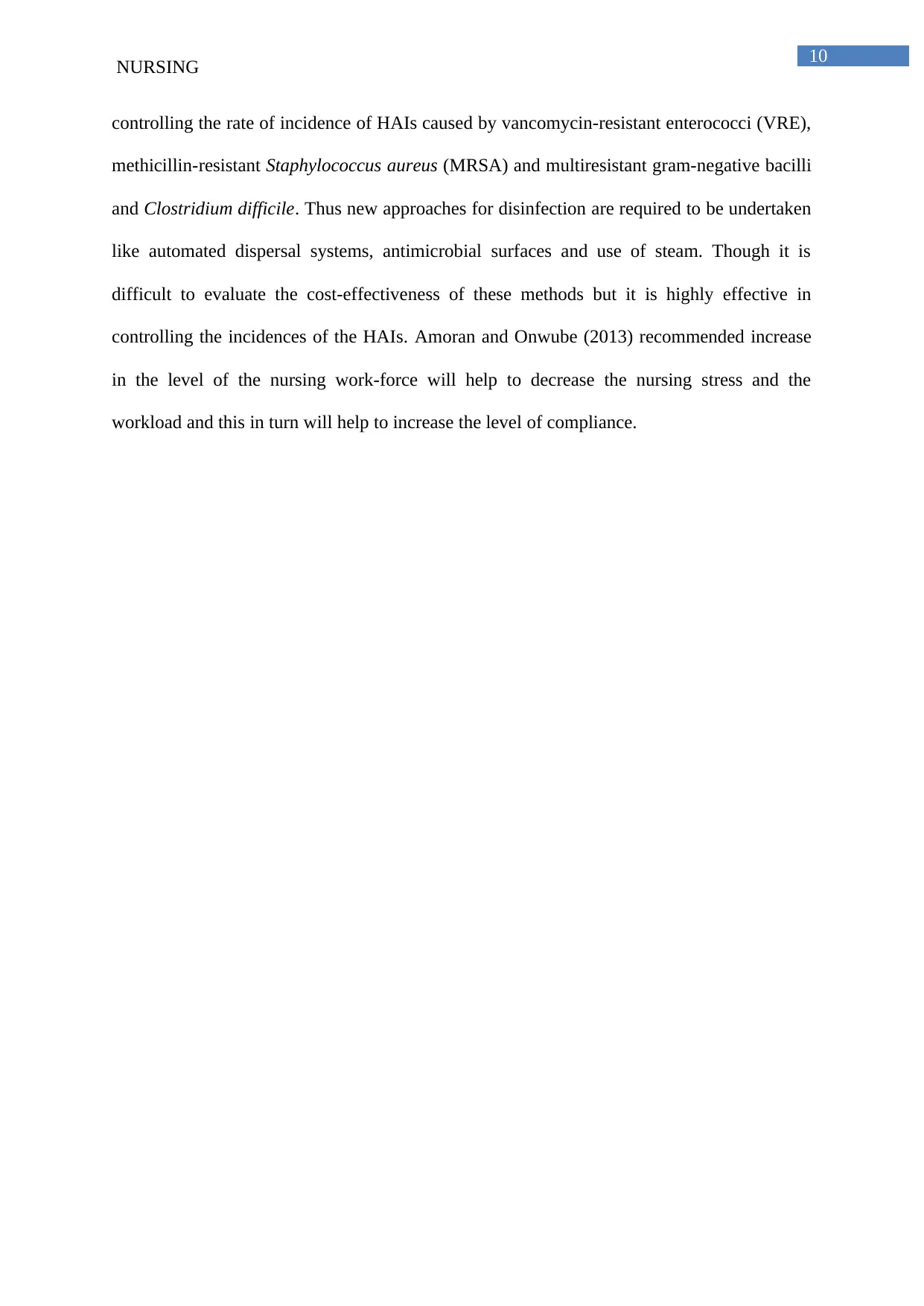
10
NURSING
controlling the rate of incidence of HAIs caused by vancomycin-resistant enterococci (VRE),
methicillin-resistant Staphylococcus aureus (MRSA) and multiresistant gram-negative bacilli
and Clostridium difficile. Thus new approaches for disinfection are required to be undertaken
like automated dispersal systems, antimicrobial surfaces and use of steam. Though it is
difficult to evaluate the cost-effectiveness of these methods but it is highly effective in
controlling the incidences of the HAIs. Amoran and Onwube (2013) recommended increase
in the level of the nursing work-force will help to decrease the nursing stress and the
workload and this in turn will help to increase the level of compliance.
NURSING
controlling the rate of incidence of HAIs caused by vancomycin-resistant enterococci (VRE),
methicillin-resistant Staphylococcus aureus (MRSA) and multiresistant gram-negative bacilli
and Clostridium difficile. Thus new approaches for disinfection are required to be undertaken
like automated dispersal systems, antimicrobial surfaces and use of steam. Though it is
difficult to evaluate the cost-effectiveness of these methods but it is highly effective in
controlling the incidences of the HAIs. Amoran and Onwube (2013) recommended increase
in the level of the nursing work-force will help to decrease the nursing stress and the
workload and this in turn will help to increase the level of compliance.
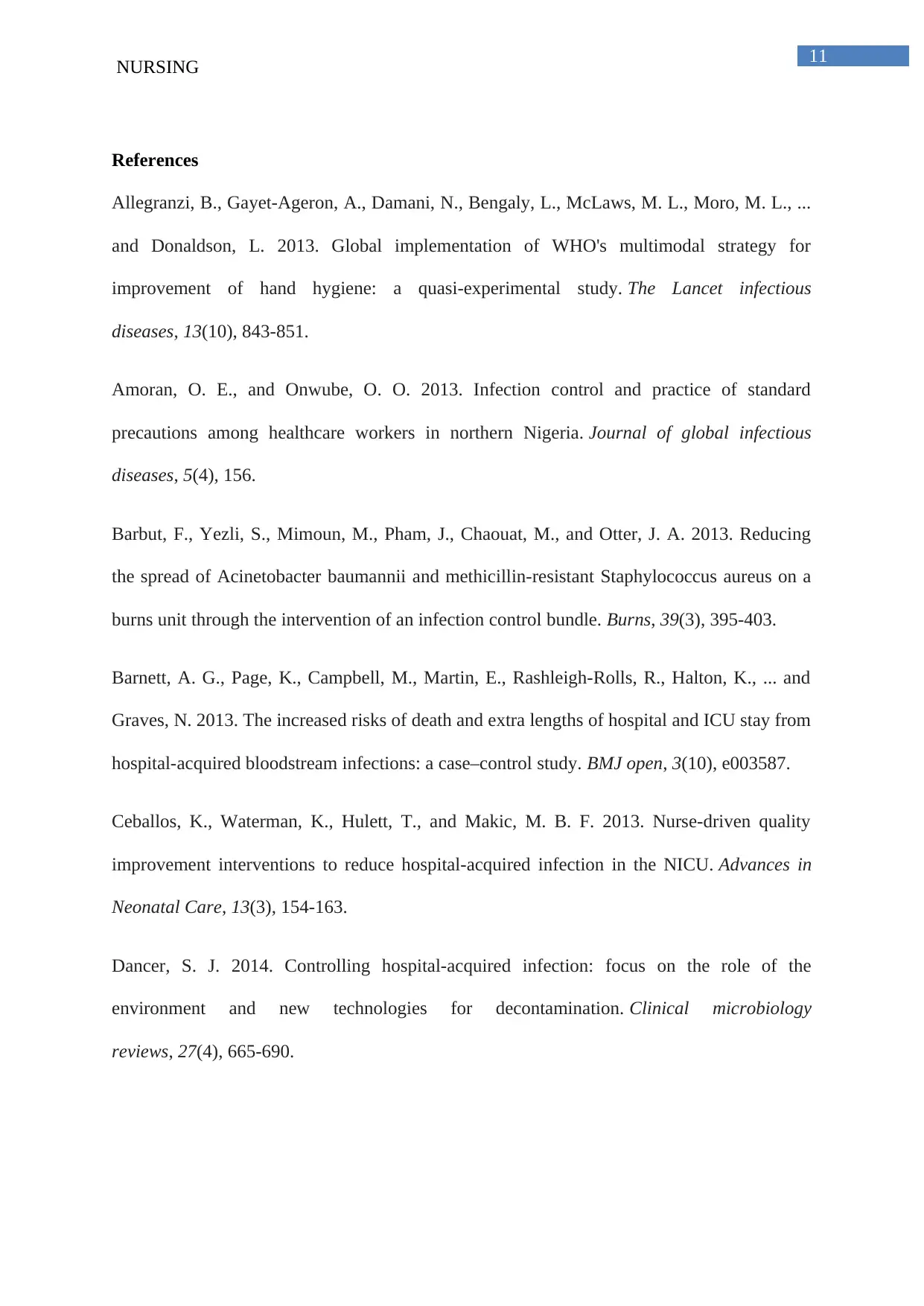
11
NURSING
References
Allegranzi, B., Gayet-Ageron, A., Damani, N., Bengaly, L., McLaws, M. L., Moro, M. L., ...
and Donaldson, L. 2013. Global implementation of WHO's multimodal strategy for
improvement of hand hygiene: a quasi-experimental study. The Lancet infectious
diseases, 13(10), 843-851.
Amoran, O. E., and Onwube, O. O. 2013. Infection control and practice of standard
precautions among healthcare workers in northern Nigeria. Journal of global infectious
diseases, 5(4), 156.
Barbut, F., Yezli, S., Mimoun, M., Pham, J., Chaouat, M., and Otter, J. A. 2013. Reducing
the spread of Acinetobacter baumannii and methicillin-resistant Staphylococcus aureus on a
burns unit through the intervention of an infection control bundle. Burns, 39(3), 395-403.
Barnett, A. G., Page, K., Campbell, M., Martin, E., Rashleigh-Rolls, R., Halton, K., ... and
Graves, N. 2013. The increased risks of death and extra lengths of hospital and ICU stay from
hospital-acquired bloodstream infections: a case–control study. BMJ open, 3(10), e003587.
Ceballos, K., Waterman, K., Hulett, T., and Makic, M. B. F. 2013. Nurse-driven quality
improvement interventions to reduce hospital-acquired infection in the NICU. Advances in
Neonatal Care, 13(3), 154-163.
Dancer, S. J. 2014. Controlling hospital-acquired infection: focus on the role of the
environment and new technologies for decontamination. Clinical microbiology
reviews, 27(4), 665-690.
NURSING
References
Allegranzi, B., Gayet-Ageron, A., Damani, N., Bengaly, L., McLaws, M. L., Moro, M. L., ...
and Donaldson, L. 2013. Global implementation of WHO's multimodal strategy for
improvement of hand hygiene: a quasi-experimental study. The Lancet infectious
diseases, 13(10), 843-851.
Amoran, O. E., and Onwube, O. O. 2013. Infection control and practice of standard
precautions among healthcare workers in northern Nigeria. Journal of global infectious
diseases, 5(4), 156.
Barbut, F., Yezli, S., Mimoun, M., Pham, J., Chaouat, M., and Otter, J. A. 2013. Reducing
the spread of Acinetobacter baumannii and methicillin-resistant Staphylococcus aureus on a
burns unit through the intervention of an infection control bundle. Burns, 39(3), 395-403.
Barnett, A. G., Page, K., Campbell, M., Martin, E., Rashleigh-Rolls, R., Halton, K., ... and
Graves, N. 2013. The increased risks of death and extra lengths of hospital and ICU stay from
hospital-acquired bloodstream infections: a case–control study. BMJ open, 3(10), e003587.
Ceballos, K., Waterman, K., Hulett, T., and Makic, M. B. F. 2013. Nurse-driven quality
improvement interventions to reduce hospital-acquired infection in the NICU. Advances in
Neonatal Care, 13(3), 154-163.
Dancer, S. J. 2014. Controlling hospital-acquired infection: focus on the role of the
environment and new technologies for decontamination. Clinical microbiology
reviews, 27(4), 665-690.
⊘ This is a preview!⊘
Do you want full access?
Subscribe today to unlock all pages.

Trusted by 1+ million students worldwide
1 out of 16
Related Documents
Your All-in-One AI-Powered Toolkit for Academic Success.
+13062052269
info@desklib.com
Available 24*7 on WhatsApp / Email
![[object Object]](/_next/static/media/star-bottom.7253800d.svg)
Unlock your academic potential
Copyright © 2020–2025 A2Z Services. All Rights Reserved. Developed and managed by ZUCOL.





